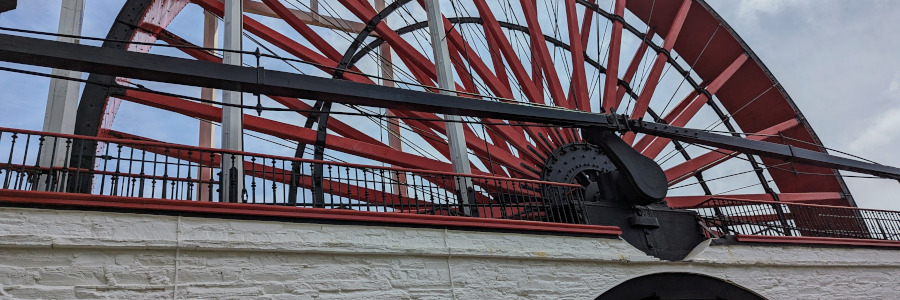Laxley Wheel (Lady Isabella)
There’s a lot to recommend the Isle of Man. A Celtic island invaded by the Norse became an amalgamation of the two. Norse with Celtic names. Celts with a parliament. The Scotts and the British passed nominal ownership of the island back and forth, but the Tynwald, the Manx parliament, celebrated its one thousand years in 1979. This is the history I expected to see when I visited. The history I found myself most engrossed with, however, was Victorian-era engineering.
The Laxley Mine had zinc, copper, and silver. Notably, it did not have coal. Coal used on the island had to be transported across the Irish Sea and was too expensive to be used when it could be avoided. The result was a mine system that needed pumping but no access to the large steam pumps of the era. The result was the Laxley Wheel, properly known as Lady Isabella.
The Laxley Wheel is a backshot water wheel that stands seventy-two and a half feet in diameter in the middle of the valley. Using a reverse siphon, it pulls its water from a cistern high in the mountains. Since water seeks its own level, a pipe from the cistern flows down the mountainside and inside the structure without needing a raceway. As long as the cistern is at a higher elevation than the wheel, through the magic of engineering, the wheel spins without a visible water source.
The wheel produces between 185-200 hp(Google Arts and Culture), and could pump 250 gallons of water 1,500 feet up from the mines each minute (Wikipedia). That’s a ton of water every minute, up 150 stories. It’s an incredible piece of engineering.
Several sources will tell you that Robert Casement designed the wheel. Almost every reference to the Laxley Wheel I’ve found calls him a “local engineer.” Not mentioned is his education, which is a matter of pride for the locals I talked to. Mr. Casement was not a trained engineer with an off-island degree. He was a Manxman with a strong practical knowledge of physics and a problem that needed to be solved. The local kid who did well, and even if it’s been 150 years, it’s a source of islander pride. I understand the sentiment.
Growing up on an island in Alaska, I was surrounded by similar folk. A friend’s father was a millwright for a local fish processor. It was said that if you wanted something fixed at the plant, you’d wait until he was in earshot and mutter that it’d be impossible. I worked at that plant in college several years after his death, and we were still using his impossible fixes. They probably still are. Another friend who was, for all practical purposes, a naval architect if they would ever give him the papers. His rudders are still in use in fishing boats across the Gulf of Alaska.
So it’s not history I witnessed when I saw the Laxley Wheel. It was an ongoing statement of pride in the local abilities of Manx Islanders. And perhaps, the pride of people at the end of the logistics chain. Where limited resources mean ordinary people are expected and allowed to do extraordinary work.
- Google Arts and Culture. “Laxey Wheel.” Google Arts and Culture, https://artsandculture.google.com/story/laxey-wheel/VwWhoQZipAby-A. Accessed 28 Aug. 2023.
- Wikipedia. “Laxley Wheel.” Wikipedia, https://en.wikipedia.org/wiki/Laxey_Wheel. Accessed 28 Aug. 2023.
